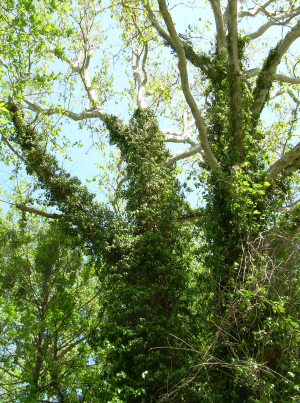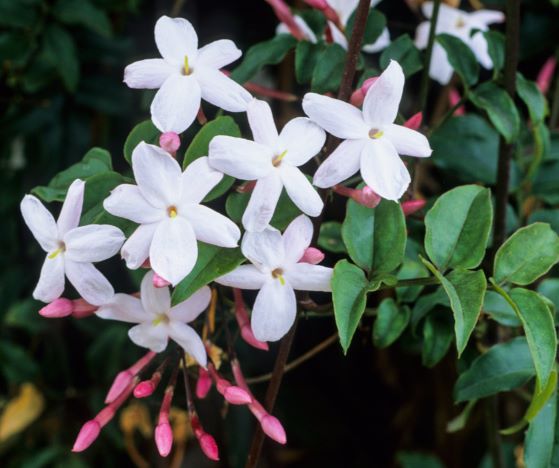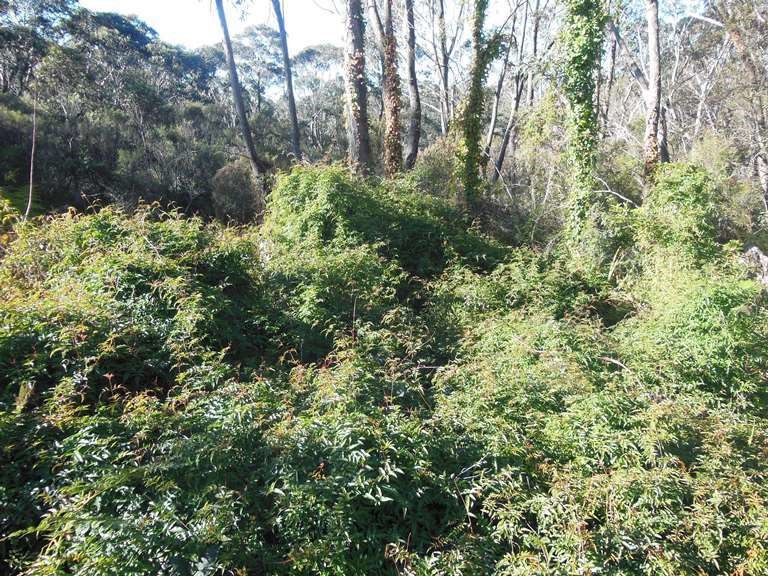Uncategorised
English Ivy (Hedera helix)
- Details
Whilst English ivy (Hedera helix) provides some lovely features and screens in our gardens this is very aggressive when out of control.
The Dandenong Ranges in Victoria (see video) are similar to Mt Wilson/Mt Irvine with the basalt soil and ornamental gardens and have a similar problem to the mounts with Ivy growing up trees and sometimes enveloping the whole tree.
Ivy is rampant in the village and eradication is difficult. However, we can all do something to limit the spread of ivy. Ivy flowers and produces fruit when it climbs up a tree and the seeds are then carried into gardens and the bush by birds. English ivy will eventually choke and kill trees, even big ones, both natives and exotics. To stop it spreading we need to focus on ivy growing on trees.
Tree Fern Treatment
For tree ferns the task is more complex as the ivy roots grow into the trunk. To kill the ivy the stems must be scraped with a knife and the herbicide applied to the ivy stem wound, being careful to avoid the tree fern trunk. This is best done in the growing season October to end April.
Non Tree Fern Tree Treatment
For other trees the process is much easier. Just cut the Ivy at the base and the Ivy should die. It is best also clearing about 1 m from the base of the tree. (see video)
Herbicide
Glyphosate (Roundup) is a herbicide that is used for killing English Ivy. Please note special care must be taken when using Glyphosate. The MWPA accepts no responsibility for the use or application of any chemicals. Always check the labels and Safety Data Sheets for all chemicals and use only as directed.
 Please note that the Blue Mountains Basalt Forest in around Mt Wilson is a ‘Blue Mountains Sensitive Vegetation Community’ so extreme care needs to be taken when controlling weeds in bushland areas. The only weed control methods recommended in sensitive areas are ‘scrape and paint’, ‘cut and paint’ and ‘stem injection’. If in any doubt about how to control weeds on your property consider using an accredited weed control contractor.
Please note that the Blue Mountains Basalt Forest in around Mt Wilson is a ‘Blue Mountains Sensitive Vegetation Community’ so extreme care needs to be taken when controlling weeds in bushland areas. The only weed control methods recommended in sensitive areas are ‘scrape and paint’, ‘cut and paint’ and ‘stem injection’. If in any doubt about how to control weeds on your property consider using an accredited weed control contractor.
Other Usefull references:
Weedwise Weed of the Month - English Ivy
Weedwise - English Ivy - Best Practices
WikiHow - How to kill English Ivy
White Jasmine (Jasminum polyanthum)
- Details
 Jasmine provides a very scented and pretty creeper but this needs to be controlled as Jasmine is a serious weed in the Rainforest.
Jasmine provides a very scented and pretty creeper but this needs to be controlled as Jasmine is a serious weed in the Rainforest.
Type of weed: Climber, scrambler or groundcover
Flowering Months: September, October, November
Native of China. A fast growing evergreen climber with small shiny green leaves and white flowers which are pink in bud and sweetly scented. Jasmine spreads by self-layering and occasional setting of seed. It can seriously threaten the rainforest edges of Mt Wilson. This plant has become a big problem in some gardens.
Alert: The flowers can cause allergies in some people.
Don’t confuse with… Jasmine can be confused with native Wonga Wonga Vine (Pandorea pandorana) before the plant develops the distinctive lobed leaves and before it flowers.
Impact on bushland
Jasmine climbs rapidly into the tree canopy and covers vegetation at all levels, blocking light and restricting the growth and regeneration of native species. Its weight may bring down branches. It is a serious weed of rainforests.

Prevention
- Keep well pruned
Control
Because of the fine twining stems and vigorous nature of this plant it is hard to eradicate.
- Dig out or spray December to March.
- Scrape and paint stems.
- If the vine has grown up into the canopy of a tree or shrub, cut each of the vine stems about 500 mm above the ground, after scraping and painting above and below the planned cut, to allow the parts in the tree canopy to die. It is important to keep the cut low to allow adequate length of the stems to be reached for re-treatment.
Alternative native plantings
- Twining Purple Pea (Hardenbergia violacea)
- Wonga Wonga Vine (Pandorea pandorana)
- Water Vine (Cissus antarctica)
- Old Man’s Beard (Clematis aristata) - note: not Clematis cultivars as these can also be environmental weeds.
Common Holly (Ilex Aquifolium)
- Details
After English Ivy, Common Holly is the most ubiquitous weed in Mt Wilson.
There are many old established Holly Trees and hedges in Mt Wilson. Whilst owners may be reluctant to remove these, care should be taken to stop the spread of Holly trees. Holly gets established very quickly and it is easiest to remove when the plants are still small. When they are seedlings they can sometimes be dug up as long as all roots are removed. Holly cuttings should all be placed in the green bin, mulched or burnt as they reshoot very easily.
The extract below is from Libby Raines weed booklet.
A native of Europe to China and North Africa. Holly is a large fast growing evergreen shrub (a small tree on Mount Wilson). It has very prickly shining green leaves and many red berries in the Autumn, which are carried by the birds. Each berry contains up to four seeds, which germinate readily in our ideal conditions, especially in the shade, and they quickly make a large self-layering shrub which usually shades out everything else around it.
Holly can be seen almost everywhere you walk on good soil. Holly and Ivy are the two most serious weeds on Mount Wilson. It is heartening to see many land owners removing holly trees from their properties.
The variegated forms of Holly are suitable to grow.
Control
- Pull or dig out small plants or spray December to March.
- Large plants cut off and poison.
Resources
After Emergency Support
- Details
Following all emergencies people are impacted and need support. This can be in the form of psychological or social support. Contact details are available below, but if you need someone to talk to or are feeling anxious or depressed then please contact one of the organisations below.

2021 Newsletters
- Details
February 2021
pdf Under and Overcliff at Wentworth Falls February 2021 (443 KB)
March 2021
pdf Ikara Ridge and Ikara Head at Mt Victoria March 2021 (431 KB)
April 2021
pdf Hat Hill to Anvil Rock at Blackheath April 2021 (413 KB)
May 2021
pdf Transit of Venus Track at Woodford May 2021 (428 KB)
June 2021
pdf Asgard Swamp and Thor Head at Mt Victoria June 2021 (426 KB)
July 2021
pdf Cancelled Leura Lookouts Walk July 2021 (441 KB)
August 2021
pdf Cancelled Leura Lookouts Walk August 2021 (427 KB)
September 2021
pdf Cancelled Leura Lookouts Walk September 2021 (429 KB)
October 2021
pdf Cancelled Leura Lookouts Walk October 2021 (434 KB)
November 2021
pdf Jinki Ridge near Mt Wilson November 2021 (432 KB)
December 2021
pdf Waterfalls, Logging Trails, The Mill and Daintree Lane at Mt Wilson December 2021 (443 KB)
